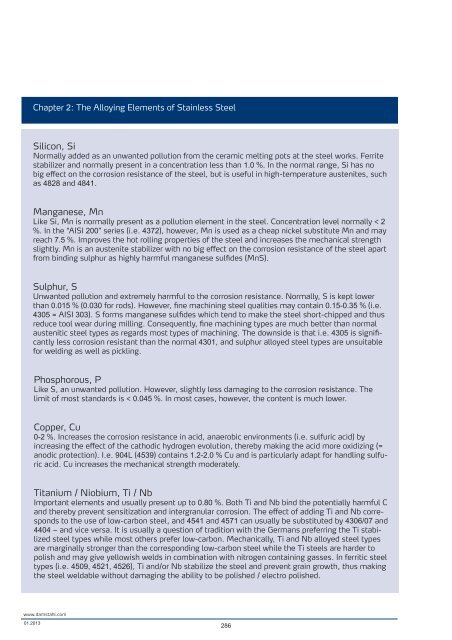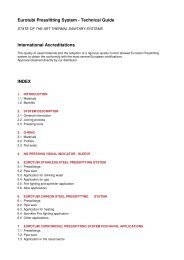Vis PDF - Damstahl
Vis PDF - Damstahl
Vis PDF - Damstahl
Create successful ePaper yourself
Turn your PDF publications into a flip-book with our unique Google optimized e-Paper software.
Chapter 2: The Alloying Elements of Stainless Steel<br />
Silicon, Si<br />
Normally added as an unwanted pollution from the ceramic melting pots at the steel works. Ferrite<br />
stabilizer and normally present in a concentration less than 1.0 %. In the normal range, Si has no<br />
big effect on the corrosion resistance of the steel, but is useful in high-temperature austenites, such<br />
as 4828 and 4841.<br />
Manganese, Mn<br />
Like Si, Mn is normally present as a pollution element in the steel. Concentration level normally < 2<br />
%. In the “AISI 200” series (i.e. 4372), however, Mn is used as a cheap nickel substitute Mn and may<br />
reach 7.5 %. Improves the hot rolling properties of the steel and increases the mechanical strength<br />
slightly. Mn is an austenite stabilizer with no big effect on the corrosion resistance of the steel apart<br />
from binding sulphur as highly harmful manganese sulfides (MnS).<br />
Sulphur, S<br />
Unwanted pollution and extremely harmful to the corrosion resistance. Normally, S is kept lower<br />
than 0.015 % (0.030 for rods). However, fine machining steel qualities may contain 0.15-0.35 % (i.e.<br />
4305 = AISI 303). S forms manganese sulfides which tend to make the steel short-chipped and thus<br />
reduce tool wear during milling. Consequently, fine machining types are much better than normal<br />
austenitic steel types as regards most types of machining. The downside is that i.e. 4305 is significantly<br />
less corrosion resistant than the normal 4301, and sulphur alloyed steel types are unsuitable<br />
for welding as well as pickling.<br />
Phosphorous, P<br />
Like S, an unwanted pollution. However, slightly less damaging to the corrosion resistance. The<br />
limit of most standards is < 0.045 %. In most cases, however, the content is much lower.<br />
Copper, Cu<br />
0-2 %. Increases the corrosion resistance in acid, anaerobic environments (i.e. sulfuric acid) by<br />
increasing the effect of the cathodic hydrogen evolution, thereby making the acid more oxidizing (=<br />
anodic protection). I.e. 904L (4539) contains 1.2-2.0 % Cu and is particularly adapt for handling sulfuric<br />
acid. Cu increases the mechanical strength moderately.<br />
Titanium / Niobium, Ti / Nb<br />
Important elements and usually present up to 0.80 %. Both Ti and Nb bind the potentially harmful C<br />
and thereby prevent sensitization and intergranular corrosion. The effect of adding Ti and Nb corresponds<br />
to the use of low-carbon steel, and 4541 and 4571 can usually be substituted by 4306/07 and<br />
4404 – and vice versa. It is usually a question of tradition with the Germans preferring the Ti stabilized<br />
steel types while most others prefer low-carbon. Mechanically, Ti and Nb alloyed steel types<br />
are marginally stronger than the corresponding low-carbon steel while the Ti steels are harder to<br />
polish and may give yellowish welds in combination with nitrogen containing gasses. In ferritic steel<br />
types (i.e. 4509, 4521, 4526), Ti and/or Nb stabilize the steel and prevent grain growth, thus making<br />
the steel weldable without damaging the ability to be polished / electro polished.<br />
www.damstahl.com<br />
01.2013<br />
286
















